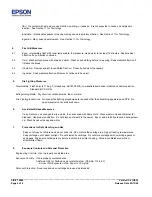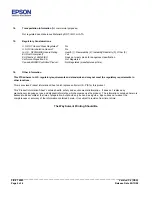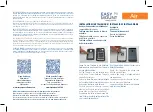
______________________________________________________________________________________________________
PIS # T6245 Version 3.6 (USA)
Page 2 of 4 Release Date 05/13/08
Skin:
Ink contact with skin may cause irritation, swelling, or redness. It is not expected to cause an allergic skin
reaction. See Section 11 for Toxicology.
Inhalation:
Intentional exposure to ink vapors may cause respiratory irritation. See Section 11 for Toxicology.
Ingestion:
May cause upset stomach. See Section 11 for Toxicology.
4.
First Aid Measures
4.1
Eyes
: Immediately flush with room temperature, low pressure, clean water for at least 15 minutes. Seek medical
attention if eye irritation continues.
4.2
Skin
: Wash surface areas with soap and water. Wash soiled clothing before re-wearing. Seek medical attention if
irritation continues.
4.3
Inhalation
: Remove subject to ventilated fresh air. Consult physician if necessary
4.4
Ingestion
: Seek medical attention if stomach continues to be upset.
5. Fire Fighting Measures
Flammability
:
Flash point is 71 deg. C (closed cup, ASTM D3278); combustible liquid under Hazardous Communication
Standard (HCS, USA)
Extinguishing Media
: Dry chemical, carbon dioxide, foam, or water
Fire Fighting Instructions
: No special fire fighting procedures are required other than breathing apparatus and PPE. No
special explosion hazards are known.
6.
Accidental Release Measures
If a spill occurs, use sponges to wipe-up ink, then rinse area with damp cloth. Place waste in closed container for
disposal. Use proper ventilation. Do not dispose of waste to the sewer. Eye or skin protection required during clean-
up. Wash hands with soap and water.
7.
Precautions for Safe Handling and Use
Keep out of reach of children and do not drink ink. Do not store the cartridge in a high or freezing temperatures.
Keep cartridge out of direct sunlight. Do not dismantle cartridge. Do not store cartridges with oxidizing agents or
explosives. Make sure cartridge is dry before insertion into printer housing. Store in ventilated area without
direct/indirect flame.
8.
Exposure Controls and Personal Protection
Engineering Controls
: Use in properly ventilated area
Exposure Controls
: Use in properly ventilated area
California OEL for Diethylene glycol diethyl ether (CAS No. 112-36-7)
8-Hour TWA Exposure Value: 5ppm or 33 mg/m3
Personal Protection
: None required when cartridges are used as intended






















